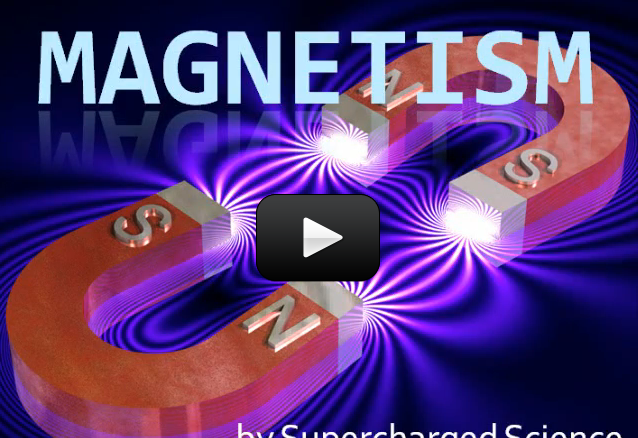This is a recording of a recent live teleclass I did with thousands of kids from all over the world. I’ve included it here so you can participate and learn, too!
Discover how to detect magnetic fields, learn about the Earth’s 8 magnetic poles, and uncover the mysterious link between electricity and magnetism that marks one of the biggest discoveries of all science…ever.
Materials:
- Box of paperclips
- Two magnets (make sure one of them ceramic because we’re going to break it)
- Compass
- Hammer
- Nail
- Sandpaper or nail file
- D cell battery
- Rubber band
- Magnet Wire
Optional Materials if you want to make the Magnetic Rocket Ball Launcher:Four ½” (12mm) neodymium magnets
- Nine ½” (12 mm) ball bearings
- Toilet paper tube or paper towel tube
- Ruler with groove down the middle
- Eight strong rubber bands
- Scissors


I don’t believe anything would ever completely stop the magnet, but a material might slow it down even more. It would have to be something highly conductive of electricity (like copper or aluminum). The strength and size of the magnet as well as the thickness of the pipe would all be variables to consider.
One more question. About eddy currents…
Is there a material that, when a magnet is dropped though a pipe made of that material, the eddy currents will slow the magnet down so much that it seems to stop completely?
Scientists don’t really know what electrons look like. Theories include that they’re spherical, egg-shaped, or neither – they could be simply a field or force with no real form. Since they are so tiny and always in motion, humans haven’t been able to observe them with normal light. We can only see their effects right now.
That sounds right. Yes, it should work!
Will this wire work as well? Remington Industries 28SNSP.25 28 AWG Magnet Wire, Enameled Copper Wire, 4 oz., 0.0135″ Diameter, 507′ Length, Red
I didn’t think far enough ahead. I want it for early next week, and it won’t ship from Jameco until next Wednesday. But I can get this off Amazon by Friday. Doesn’t do me any good, though, if it won’t work for this unit.
Thanks!
In this video, you said that even if scientists had a really really really really really really really (okay you didn’t say “really” that many times) strong microscope, you still couldn’t see electrons because they’re moving so fast.
I had just watched some of your videos on relativity in astronomy, and as I watched this magnetism video, I wondered: If you could get an atom to move fast enough, and you had that really good microscope, could you take a picture of an electron right as it passed under the microscope, assuming you had really good timing with your camera? What would the electron look like?
When you break a bar magnet apart, you get two new (smaller) magnets like this:
N========S breaks into two pieces like this: N====S N====S
If you take one of those pieces and break it, you get: N====S becoming N==S N==S
And if you break those apart, you get: N==S becoming N=S N=S
You can keep doing this until you get to a single atom.
I noticed an error in the teleclass video that I just updated to make it more clear (around 43 minutes). You have to check where the magnet’s poles are first before you break the magnet. Try to use a magnet that has a pole at each end, not a pole at the top and bottom surfaces.
If you have a circular magnet, you have to look where the N and S are. Sometimes they are on the top and bottom surfaces (and then they’re not really poles), and other times they are on one side and the other, like cutting a donut into two C shapes, where each “C” is a N or S.
We have a question about breaking magnets. We don’t understand how the poles change? If this is the magnet +[ ]- and we break it in the middle, it would seem like now we would have +[ ]- and +[ ]- and they should still attract. We did break a magnet, and they obviously don’t attract, they repelled. But, we don’t understand how those original end poles change? Do all the poles just get mixed up and changed? You say in the video that they sprout new poles; does that mean that all poles change and reorient to the break points? We would love some more information on that if we could get it? Thanks. (Mom is helping me and we both want to know), Issachar
You’re asking a much more complicated question than I think you realize. Awesome job! Great scientists are always asking questions, no matter how smart they are or how old they are. 🙂
Let’s see if we can take it in two steps:
1. Electrons are influenced by magnetic fields, but it’s really hard to analyze how they do this. You usually cover this in college physics and it looks something like this:
http://hyperphysics.phy-astr.gsu.edu/hbase/magnetic/magint.html#c1
2. There are very specific places electrons can be in an atom. There’s no “in between” space – it’s either on track A or track B, for example. There’s no way it can be in between different “tracks” (energy levels, really). These locations are not changed when the atom is inside a magnetic field. (This might not be the case in very strong magnetic fields, like near magnetars, but as far as I can tell, this has never been tested.)
If electrons are drawn to a magnet, then could other things get closer to the nucleus than they normally would when the electrons are not being drawn to a magnet?